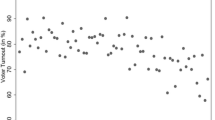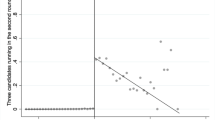Abstract
We present a model for identifying the components of aggregate change in an electorate between two points in time. When the electorate is constant in size, change in the mean opinion disaggregates into two components: conversion among those who continue to participate in the electorate (Stayers), and replacement of those who drop out of the electorate at Time1 (Dropouts) by Newcomers to the electorate at Time2. We add to this simple formulation the possibility of variation in the size of the electorate. When an electorate expands, the model includes a mobilization term to accommodate the fact that there are more Newcomers at Time2 than Dropouts at Time1. When an electorate shrinks in size, the demobilization term reflects the fact that Newcomers as a group are smaller than Dropouts. The model includes appropriate weights for each component so that the change in opinion (or any other aggregate characteristic in the electorate) can be allocated across the three components. We apply the model to Iowa caucus attenders in both parties between 1984 and 1988, and we suggest that the model can be also productively applied to a variety of contexts besides nomination politics, where fluctuations in the size of electorates are significant.
Similar content being viewed by others
References
ABC News (1989).The '88 Vote, New York: Capital Cities/ABC News.
Anderson, Kristi (1979).The Creation of a Democratic Majority: 1928–1936. Chicago: University of Chicago Press.
Asher, Herbert, and Herbert Weisberg (1978). Voting change in Congress: Some dynamic perspectives on an evolutionary process.American Journal of Political Science 22: 391–425.
Beck, Paul A. (1974). A Socialization Theory of Partisan Realignments. InThe Politics of Future Citizens, ed, Richard Niemi. San Francisco: Jossey-Bass.
Boudon, Raymond (1975). A model for the analysis of mobility tables. In, H. M. Blalock, A. Aganbegian, F. M. Borodkin, Rayond Boudon, and Vittorio Capecchi (eds.),Quantitative Sociology. New York: Academic Press.
Burnham, Walter Dean (1970).Critical Elections and the Mainsprings of American Politics. New York: Norton.
Burnham, Walter Dean (1987). The turnout problem. In James Reichley (ed.),Elections American Style. Washington D. C.: Brookings Institution.
Butler, David, and Donald E. Stokes (1969).Political Change in Britain. New York: St. Martin's.
Campbell, James C. (1985). Sources of the new deal realignment: The contributions of conversion and mobilization to partisan change.Western Political Quarterly 38: 357–376.
Carmines, Edward, and James Stimson (1989).Issue Evolution. Princeton: Princeton University Press.
Clubb. Jerome M., William H. Flanigan, and Nancy H. Zingale (1986). In Samuel Long (ed.),Research in Micropolitics. Vol. 1). Greenwich, Connecticut.
Converse, Philip E. (1964). The belief systems of mass publics. In David Apter (ed.),Ideology and Discontent. Glencoe, IL: Free Press.
Converse, Philip E., and Gregory B. Markus (1979). Plus ça Change ...: The New CPS Election Study Panel.American Political Science Review 73: 32–49.
Edsall, Thomas (1984).The Politics of Inequality. New York: Norton.
Eldersveld, Samuel (1964).Political Parties. Chicago: Rand McNally.
Erikson, Robert S., and Kent L. Tedin (1981). The 1928–1936 partisan realignment: The case for the conversion hypothesis.American Political Science Review 75: 951–962.
Grenzke, Janet Miller (1982).Influence Change and the Legislative Process. Westport, CT: Greenwood Press.
Jacobson, Gary (1992).The Politics of Congressional Elections (3rd Ed.). New York: Harper, Collins.
Jones, Charles (1990). The separated presidency-making it work in contemporary politics. In Anthony King (ed.),The New American Political System (2nd Version), Washington, D. C.: The AEI Press.
Mayhew, David R. (1974).Congress: The Electoral Connection. New Haven, CT: Yale University Press.
Miller, Warren E. and M. Kent Jennings (1986).Parties in Transition. New York: Russell Sage Foundation.
Petrocik, John R. (1987). Realignment: New party coalitions and the nationalization of the south.Journal of Politics 49: 347–375.
Pierce, Roy and Thomas R. Rochon (1984). Attitudinal change and elite circulation: French socialist candidates in 1967 and 1978.American Journal of Political Science 28: 379–398.
Piven, Frances Fox and Richard A. Cloward (1988).Why Americans Don't Vote. New York: Pantheon.
Polsby, Nelson W. (1968). The institutionalization of the U. S. House of Representatives.American Political Science Review 62: 144–168.
Rothenberg, Lawrence S. and Richard A. Brody (1988). Participation in presidential primaries.Western Political Quarterly 41: 253–272.
Shafer, Byron E. (1991).The End of Realignment? Interpreting American Electoral Eras. Madison, WI: Universit of Wisconsin Press.
Shively, W. Phillips (1992). From differential abstention to conversion: A change in electoral change, 1864–1988.American Journal of Political Science 36: 309–330.
Stone, Walter J., Ronald B. Rapoport, and Alan I. Abramowitz (1990). The Reagan revolution and partisan polarization in the 1980s. In L. Sandy Maisel (ed.),The Parties Respond. Boulder, CO: Westview Press.
Stone, Walter J., Lonna Rae Atkeson, and Ronald B. Rapoport (1992). Turning on or turning off? Mobilization and demobilization effects of participation in presidential nomination campaigns.American Journal of Political Science 36: 665–691.
Sundquist, James L. (1983).Dynamics of the Party System (2nd Ed.). Washington, D. C.: Brookings Institution.
Author information
Authors and Affiliations
Additional information
Ronald B. Rapoport. College of William and Mary.
Rights and permissions
About this article
Cite this article
Rapoport, R.B., Stone, W.J. A model for disaggregating political change. Polit Behav 16, 505–532 (1994). https://doi.org/10.1007/BF01498828
Issue Date:
DOI: https://doi.org/10.1007/BF01498828




